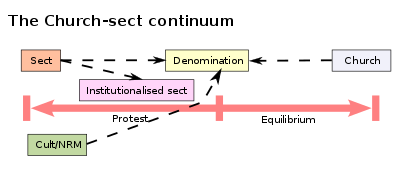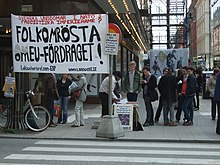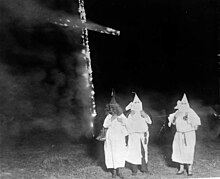The anti-cult movement (abbreviated ACM; sometimes called the countercult movement) is a social group which opposes any new religious movement (NRM) that they characterize as a cult. Sociologists David Bromley and Anson Shupe initially defined the ACM in 1981 as a collection of groups embracing brainwashing-theory, but later observed a significant shift in ideology towards pathologizing membership in NRMs. One element within the anti-cult movement, Christian counter-cult organizations, oppose NRMs on theological grounds and distribute information to this effect through church networks and via printed literature.
The concept of an ACM
The
anti-cult movement is conceptualized as a collection of individuals and
groups, whether formally organized or not, who oppose some new
religious movements (or "cults"). This countermovement has reportedly recruited participants from family members of "cultists", former group members (or apostates), religious groups (including Jewish groups) and associations of health professionals. Although there is a trend towards globalization, the social and organizational bases vary significantly from country to country according to the social and political opportunity structures in each place.
As with many subjects in the social sciences, the movement is
variously defined. A significant minority opinion suggests that analysis
should treat the secular anti-cult movement separately from the
religiously motivated (mainly Christian) groups.
The anti-cult movement might be divided into four classes:
- secular counter-cult groups;
- Christian evangelical counter-cult groups;
- groups formed to counter a specific cult; and
- organizations that offer some form of exit counseling.
Most, if not all, the groups involved express the view that there are
potentially deleterious effects associated with some new religious
movements.
Religious and secular critics
Commentators differentiate two main types of opposition to "cults":
- religious opposition: related to theological issues.
- secular opposition: related to emotional, social, financial, and economic consequences of cult involvement, where "cult" can refer to a religious or to a secular group.
Barker's five types of cult-watching groups
According to sociologist Eileen Barker,
cult-watching groups (CWGs) disseminate information about "cults" with
the intent of changing public and government perception as well as of
changing public policy regarding NRMs.
Barker has identified five types of CWG:
- cult-awareness groups (CAGs) focusing on the harm done by "destructive cults"
- counter-cult groups (CCGs) focusing on the (heretical) teaching of non-mainstream groups
- research-oriented groups (ROGs) focusing on beliefs, practices and comparisons
- human-rights groups (HRGs) focusing on the human rights of religious minorities
- cult-defender groups (CDGs) focusing on defending cults and exposing CAGs
Hadden's taxonomy of the anti-cult movement
Jeffrey K. Hadden sees four distinct classes of opposition to "cults":
- Opposition grounded on Religion
- Opposition usually defined in theological terms.
- Cults considered heretical.
- Endeavors to expose the heresy and correct the beliefs of those who have strayed from a truth.
- Prefers metaphors of deception rather than possession.
- Serves two important functions:
- protects members (especially youth) from heresy, and
- increases solidarity among the faithful.
- Secular opposition
- Regards individual autonomy as the manifest goal – achieved by getting people out of groups using mind control and deceptive proselytization.
- Regards the struggle as an issue of control rather than theology.
- Organizes around families of children currently or previously involved in a cult.
- Has the unannounced goal of disabling or destroying NRMs organizationally.
- Apostates
- Former members who consider themselves egregiously wronged by a cult, often with the coordination and encouragement of anti-cult groups.
- Entrepreneurial opposition
- A few "entrepreneurs" who have made careers of organizing opposition groups.
- Broadcasters, journalists, and lawyers who base a reputation or career on anti-cult activities
Cult-watching groups and individuals, and other opposition to cults
Family-members of adherents
Some
opposition to cults (and to some new religious movements) started with
family-members of cult-adherents who had problems with the sudden
changes in character, lifestyle and future plans of their young adult
children who had joined NRMs. Ted Patrick, widely known as "the father of deprogramming", exemplifies members of this group. The former Cult Awareness Network (old CAN) grew out of a grassroots-movement by parents of cult-members. The American Family Foundation (today the International Cultic Studies Association) originated from a father whose daughter had joined a high-control group.
Clinical psychologists and psychiatrists
From
the 1970s onwards some psychiatrists and clinical psychologists accused
"cults" of harming some of their members. These accusations were
sometimes based on observations made during therapy, and sometimes were
related to theories regarding brainwashing or mind-control.
Former members
Anson Shupe, David G. Bromley and Joseph Ventimiglia coined the term atrocity tales in 1979, which Bryan R. Wilson
later took up in relation to former members' narratives. Bromley and
Shupe defined an "atrocity tale" as the symbolic presentation of action
or events, real or imagined, in such a context that they come to
flagrantly violate the (presumably) shared premises upon which a given
set of social relationships should take place. The recounting of such
tales has the intention of reaffirming normative boundaries. By sharing
the reporter's disapproval or horror, an audience reasserts normative
prescription and clearly locates the violator beyond the limits of public morality.
Christian countercult movement
In the 1940s, the long-held opposition by some established Christian denominations to non-Christian religions or supposedly heretical, or counterfeit, Christian sects crystallized into a more organized Christian counter cult movement
in the United States. For those belonging to the movement, all
religious groups claiming to be Christian, but deemed outside of
Christian orthodoxy, were considered "cults". Christian cults are new religious movements which have a Christian background but are considered to be theologically deviant by members of other Christian churches. In his influential book The Kingdom of the Cults, first published in the United States in 1965, Christian scholar Walter Martin
defines Christian cults as groups that follow the personal
interpretation of an individual, rather than the understanding of the Bible accepted by mainstream Christianity. He mentions The Church of Jesus Christ of Latter-day Saints, Christian Science, the Jehovah's Witnesses, Unitarian Universalism, and Unity as examples.
The Christian countercult movement asserts that Christian sects
whose beliefs are partially or wholly not in accordance with the Bible
are erroneous. It also states that a religious sect can be considered a
"cult" if its beliefs involve a denial of what they view as any of the
essential Christian teachings such as salvation, the Trinity, Jesus himself as a person, the ministry of Jesus, the Miracles of Jesus, the Crucifixion of Jesus, the Death of Christ, the Resurrection of Christ, the Second Coming of Christ, and the Rapture.
Countercult literature usually expresses doctrinal or theological concerns and a missionary or apologetic purpose. It presents a rebuttal by emphasizing the teachings of the Bible
against the beliefs of non-fundamental Christian sects. Christian
countercult activist writers also emphasize the need for Christians to evangelize to followers of cults.
Governmental opposition
The secular opposition to cults and new religious movements operates
internationally, though a number of sizable and sometimes expanding
groups originated in the United States. Some European countries, such as
France, Germany, Belgium and Switzerland have introduced legislation or
taken other measures against cults or "cultic deviations".
In the Netherlands "cults", sects, and new religious movements have the same legal rights as larger and more mainstream religious movements. As of 2004, the Netherlands do not have an anti-cult movement of any significance.
National anti-cult movements
United States
The
first organised opposition to new religions in the United States
appeared in 1972 with the formation of FREECOG (Parents Committee to
Free Our Sons and Daughters from the Children of God).
In 1973 FREECOG renamed itself as the Volunteer Parents of America, and
then the Citizens Freedom Foundation (CFF), before becoming the Cult
Awareness Network (CAN) in 1984. In 1987, Ian Harworth founded another such group, the Cult Information Centre.
In 1979, another anti-cult group, the American Family Foundation (AFF)
was founded; it began organising annual conferences, launching an
information phone line, and publishing the Cult Observer and the Cultic Studies Journal. The CAN and AFF were separate organisations although fashioned a number of joint boards and programmes. In 1996 the CAN was sued for its involvement in the deprogramming of a member of the American Pentecostal Church. This bankrupted the organisation, and its name was purchased by a group which included a number of Scientologists. In the 1970s and 1980s American anti-cultist Ted Patrick was convicted several times for kidnapping and unlawful imprisonment for his deprograming activities.
United Kingdom
In the UK, the politician Paul Rose established an anti-cult group called FAIR (Family Action Information and Resource) in 1976.
Russia
In Russia "anticultism" appeared in early 1990s. Some Russian Protestants
criticized foreign missionaries, sects and new religious movements.
They perhaps hoped that taking part in anti-cult declarations could
demonstrate that they were not "sectarians".
Some religious studies have shown that anti-cult movements, especially
with support of the government, can provoke serious religious conflicts
in Russian society. In 2008 the Russian Ministry of Internal Affairs
prepared a list of "extremist groups". At the top of the list were
Islamic groups outside of "traditional Islam", which is supervised by
the Russian government. Next listed were "Pagan cults". In 2009 the Russian Ministry of Justice created a council which it named the Council of Experts Conducting State Religious Studies Expert Analysis.
The new council listed 80 large sects which it considered potentially
dangerous to Russian society, and mentioned that there were thousands of
smaller ones. Large sects listed included The Church of Jesus Christ of Latter-day Saints, Jehovah's Witnesses, and what were called "neo-Pentecostals."
Controversies
Polarized views among scholars
Social
scientists, sociologists, religious scholars, psychologists and
psychiatrists have studied the modern field of "cults" and new religious
movements since the early 1980s. Debates about certain purported cults
and about cults in general often become polarized with widely divergent
opinions, not only among current followers and disaffected former
members, but sometimes among scholars as well.
All academics agree that some groups have become problematic and
sometimes very problematic, but they disagree over the extent to which
new religious movements in general cause harm. Bryan Wilson
makes this point in his paper saying that the Bruderhof is not a cult,
pointing out that the public imagination is captured by five events that
have occurred in religious groups: Jonestown, the Branch Davidians, Solar Temple, Aum Shinrikyo and Heaven's Gate.
Several scholars have questioned Hadden's attitude towards NRMs and cult critics as one-sided.
Scholars in the field of new religious movements confront many controversial subjects:
- The validity of the testimonies of former members.
- The validity of the testimonies of current members.
- The validity of and differences between exit counseling and coercive deprogramming.
- The validity of evidence of harm caused by "cults".
- Ethical concerns regarding new religious movements, for example free will and freedom of speech.
- Opposition to "cults" vs. freedom of religion and religious intolerance.
- The objectivity of all scholars studying new religious movements (see NRM apologists).
- The acceptance or rejection of the APA Task Force on Deceptive and Indirect Methods of Persuasion and Control report (Amitrani & di Marzio, 2000, Massimo Introvigne), see also scholarly positions on mind control.
Janet Jacobs expresses the range of views on the membership of the
perceived ACM itself, ranging from those who comment on "the value of
the Cult Awareness Network, the value of exit therapy for former members
of new religious movements, and alternative modes of support for family
members of individuals who have joined new religions" and extending to
"a more critical perspective on [a perceived] wide range of ACM
activities that threaten religious freedom and individual rights."
Brainwashing and mind-control
Over the years various controversial theories of conversion
and member retention have been proposed that link mind control to NRMs,
and particularly those religious movements referred to as "cults" by their critics. These theories resemble the original political brainwashing theories first developed by the CIA as a propaganda device to combat communism, with some minor changes. Philip Zimbardo
discusses mind control as "... the process by which individual or
collective freedom of choice and action is compromised by agents or
agencies that modify or distort perception, motivation, affect,
cognition and/or behavioral outcomes", and he suggests that any human being is susceptible to such manipulation. In a 1999 book, Robert Lifton also applied his original ideas about thought reform to Aum Shinrikyo, concluding that in this context thought reform was possible without violence or physical coercion. Margaret Singer, who also spent time studying the political brainwashing of Korean prisoners of war, agreed with this conclusion: in her book Cults in Our Midst she describes six conditions which would create an atmosphere in which thought reform is possible.
James T. Richardson
observes that if the NRMs had access to powerful brainwashing
techniques, one would expect that NRMs would have high growth rates, yet
in fact most have not had notable success in recruitment. Most
adherents participate for only a short time, and the success in
retaining members is limited. For this and other reasons, sociologists of religion including David G. Bromley and Anson D. Shupe consider the idea that cults are brainwashing American youth to be "implausible". In addition to Bromley, Thomas Robbins, Dick Anthony, Eileen Barker, Newton Maloney, Massimo Introvigne, John Hall, Lorne L. Dawson, Anson D. Shupe, J. Gordon Melton, Marc Galanter, Saul Levine of Mount Wilson FM Broadcasters, Inc,
amongst other scholars researching NRMs, have argued and established to
the satisfaction of courts, relevant professional associations and
scientific communities that there exists no scientific theory, generally
accepted and based upon methodologically sound research, that supports
the brainwashing theories as advanced by the anti-cult movement.
Deprogramming or exit-counseling
Some members of the secular opposition to cults and to some new
religious movements have argued that if brainwashing has deprived a
person of their free will, treatment to restore their free will should
take place, even if the "victim" opposes this.
Precedents for this exist in the treatment of certain mental illnesses:
in such cases medical and legal authorities recognize the condition as
depriving sufferers of their ability to make appropriate decisions for
themselves. But the practice of forcing treatment on a presumed victim
of "brainwashing" (one definition of "deprogramming") has constantly proven controversial. Human-rights organizations (including the ACLU and Human Rights Watch)
have criticized deprogramming, too. While only a small fraction of the
anti-cult movement has had involvement in deprogramming, several
deprogrammers (including a deprogramming-pioneer, Ted Patrick)
have served prison-terms for acts sometimes associated with
deprogramming including kidnapping and rape, while courts have acquitted
others.
Responses of targeted groups and scholars
The Foundation against Intolerance of Religious Minorities, associated with the Adidam
NRM, sees the use of terms "cult" and "cult leader" as detestable and
as something to avoid at all costs. The Foundation regards such usage as
the exercise of prejudice and discrimination against them in the same
manner as the words "nigger" and "commie" served in the past to denigrate blacks and Communists.
CESNUR's president Massimo Introvigne, writes in his article "So many evil things: Anti-cult terrorism via the Internet",
that fringe and extreme anti-cult activists resort to tactics that may
create a background favorable to extreme manifestations of discrimination and hate against individuals that belong to new religious movements. Professor Eileen Barker
points out in an interview that the controversy surrounding certain new
religious movements can turn violent by a process called deviancy amplification spiral.
In a paper presented at the 2000 meeting of the Society for the
Scientific Study of Religion, Anson Shupe and Susan Darnell argued that
although the International Cultic Studies Association
(ICSA, formerly known as AFF or American Family Foundation) has
presented "... slanted, stereotypical images and language that has
inflamed persons to perform extreme actions", the extent to which one
can classify the ICSA and other anti-cult organizations as "hate-groups"
(as defined by law in some jurisdictions or by racial or ethnic
criteria in sociology) remains open to debate. In 2005, the Hate Crimes
Unit of the Edmonton Police Service confiscated anti-Falun Gong materials distributed at the annual conference of the ICSA by staff members of the Chinese Consulate in Calgary.
The materials, including the calling of Falun Gong a "cult", were
identified as having breached the Criminal Code, which bans the willful
promotion of hatred against identifiable religious groups.
An article on the categorization of new religious movements in US media published by The Association for the Sociology of Religion (formerly the American Catholic Sociological Society)
criticizes the print media for failing to recognize social-scientific
efforts in the area of new religious movements, and its tendency to use
anti-cultist definitions rather than social-scientific insight, and
asserts that The failure of the print media to recognize
social-scientific efforts in the area of religious movement
organizations (as our previous research [van Driel and Richardson, 1985]
also shows) impels us to add yet another failing mark to the media
report card Weiss (1985) has constructed to assess the media's reporting
of the social sciences.







